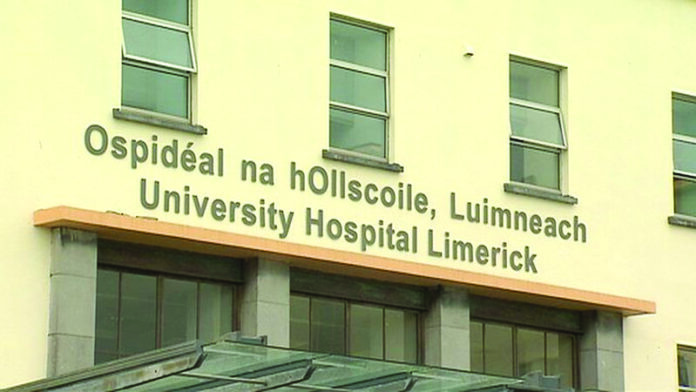
MANAGEMENT at the chronically overcrowded University Hospital Limerick (UHL) are coming under mounting pressure with local politicians Willie O’Dea and Maurice Quinlivan declaring they have little or no confidence in its leadership.
Concern for patient safety at UHL has grown after a number of recent patient deaths and the revelation by Sinn Féin TD Maurice Quinlivan that a 71-year old Limerick man spent eight days on a trolley at the hospital last week.
Limerick TDs Willie O’Dea (Fianna Fáil) and Maurice Quinlivan said it was “hard” to have confidence in the UHL management while overcrowding continued to worsen, despite a specialised HSE taskforce parachuting into the hospital last year, as well as recent investment in the hospital by the Department of Health.
Independent County Limerick TD Richard O’Donoghue has also made repeated calls for senior UL Hospitals Groups officials (the body in charge of UHL) to step down, while Bernard Gloster, the head of the HSE, and Health Minister Stephen Donnelly had both recently declined to specifically endorse management.
‘How could you have confidence … when you have a horror story at the hospital every single day?’
Colette Cowan, ULHG chief executive, has been on leave since early February. Around the same time as Ms Cowan’s temporary departure, a record 150 patients in a single day were left waiting on trolleys and chairs in the corridors of the hospital’s overwhelmed emergency department and wards.
“There has to be an immediate government intervention at UHL. This is all down to lack of resources, staff, and capacity,” Deputy Quinlivan said.
Asked whether he had confidence in ULHG, Mr Quinlivan replied: “Well, how could you have confidence in people when you have a horror story at the hospital every single day?”
The Sinn Fein TD said he had to “personally intervene” last week in the case of a 71-year-old stroke patient “who was eight days on a trolley” at UHL.
“Nobody should be that length of time on a trolley, but we see it every single day, the whole system is chaotic and the problem goes back to 2009 when the then government closed down EDs (emergency departments) in Nenagh, Ennis, St John’s.
“There is definitely a case for reopening a second emergency department in the Mid West region,” Deputy Quinlivan added.
Concerns falling on deaf ears
While the Taoiseach has ruled this out, Fianna Fáil TD Willie O’Dea has urged the government to reconsider.
Deputy O’Dea said that his party had “not followed through” with reconfiguring 24-hour accident and emergency services in Clare and north Tipperary, adding that “sufficient monies haven’t been provided” to buffer the impact on UHL’s ED following the closure of the region’s other full time ED units in 2009.
The Fianna Fáil TD said he had raised his concerns in the Dáil about overcrowding at UHL, but complained this was effectively falling on deaf ears.
Deputy O’Dea acknowledged the hospital’s managers have a “very difficult job” but he said he also found it “hard to have confidence” in the hospital group.
“My assessment is quite simple: there are not enough beds in UHL to service the population of the area that it is supposed to be servicing,” Deputy O’Dea added.
Limerick Fianna Fáil Minister of State at the Department of Skills and Further Education, Niall Collins, said the government is trying to provide solutions and “is not sticking our heads in the sand and denying there are huge challenges”.
“The health minister has increased ULHG’s operating budget by 25 per cent, has increased its workforce by about 1,000, has added 130 beds to the hospital group, 96 more beds are under construction, and 96 more are planned.”
Minister Collins said his department has made a “huge effort” tackling a shortage of GPs, “so much so, that the numbers of GPs being trained has almost trebled”.
“Between training GPs here and recruiting GPs from abroad means that now, for every GP that is retiring, there is two coming on stream.”
‘Not fit for purpose’
Mary Cahillane, of the Mid West Hospital Campaign, said she believed that changing UHL’s management would not solve the overcrowding crisis. Instead, she said further investment in beds and staff and the reversal of the closure of accident and emergency units would tackle the problem.
“UHL’s ED was supposed to cater for 70,000 patients annually, but, last year, over 80,000 went through its doors. It is not fit for purpose,” she said.
The UL Hospitals Group responded by saying that overcrowding “is a complex, multi-faceted challenge” and that UHL “has a well-documented deficit in bed capacity”.
It said 192 beds were due to come on stream in the next few years, 96 by the first quarter of 2025, but this would not address the immediate overcrowding “and long waits for inpatient beds that are a regular feature in UHL currently”.
The group said it was “managing some of the highest attendances” at its ED and that long waits for beds for patients was “a source of great regret and we apologise”.
It provided latest available patient attendance figures for UHL, showing that, up to February 4 this year, ED presentations at UHL increased by 23 per cent on last year, with emergency admissions up 14 per cent.
It said it had started several patent flow initiatives particularly focused on “geriatric ED-avoidance unit for over 75s”.
The group said it had recruited 21.5 whole-time equivalent additional ED staff nurses, two additional ED consultants, and an extra 20 non-consult hospital doctors.










